
Home - Search - Browse - Alphabetic Index: 0- 1- 2- 3- 4- 5- 6- 7- 8- 9
A- B- C- D- E- F- G- H- I- J- K- L- M- N- O- P- Q- R- S- T- U- V- W- X- Y- Z
Apollo 17
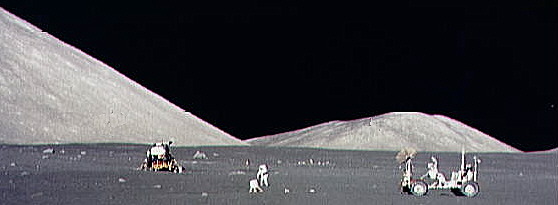
Apollo 17
Apollo 17 landing site
Credit: NASA
AKA: America. Launched: 1972-12-07. Returned: 1972-12-19. Number crew: 3 . Duration: 12.58 days. Location: Space Center Houston (NASA Johnson Space Center's Visitor Center), Houston, TX.
Apollo 17 (AS-512), the final Apollo manned lunar landing mission, was launched from Pad A, Launch Complex 39, KSC, at 12:33 a.m. EST December 7. Crew members were astronauts Eugene A. Cernan, Ronald E. Evans, and Harrison H. Schmitt. The launch had been delayed 2 hours 40 minutes by a countdown sequencer failure, the only such delay in the Apollo program caused by a hardware failure.
All launch vehicle systems performed normally in achieving an earth parking orbit of 170 by 168 kilometers. After checkout, insertion into a lunar trajectory was begun at 3:46 a.m.; translunar coast time was shortened to compensate for the launch delay. CSM 114 transposition, docking with LM-12, and LM ejection from the launch vehicle stage were normal. The S-IVB stage was maneuvered for lunar impact, striking the surface about 13.5 kilometers from the preplanned point at 3:27 p.m. EST December 10. The impact was recorded by the passive seismometers left on the moon by Apollo 12, 14, 15, and 16.
The crew performed a heat flow and convection demonstration and an Apollo light-flash experiment during the translunar coast. The scientific instrument module door on the SM was jettisoned at 10:17 a.m. EST December 10. The lunar orbit insertion maneuver was begun at 2:47 p.m. and the Apollo 17 spacecraft entered a lunar orbit of 315 by 97 kilometers. After separation of the LM Challenger from the CSM America and a readjustment of orbits, the LM began its powered descent and landed on the lunar surface in the Taurus-Littrow region at 2:55 p.m. EST on December 11, with Cernan and Schmitt.
The first EVA began about 4 hours later (6:55 p.m.). Offloading of the lunar roving vehicle and equipment proceeded as scheduled. The Apollo Lunar Surface Experiment Package was deployed approximately 185 meters west northwest of the Challenger. Astronaut Cernan drove the lunar roving vehicle to the experiments deployment site, drilled the heat flow and deep core holes, and emplaced the neutron probe experiment. Two geological units were sampled, two explosive packages deployed, and seven traverse gravimeter measurements were taken. During the 7-hour 12-minute EVA, 14 kilograms of samples were collected.
The second extravehicular activity began at 6:28 p.m. EST December 12. Because of geological interest, station stop times were modified. Orange soil was discovered and became the subject of considerable geological discussion. Five surface samples and a double core sample were taken in the area of the orange soil. Three explosive packages were deployed, seven traverse gravimeter measurements were taken, and observations were photographed. Samples collected totaled 34 kilograms during the 7 hours and 37 minutes of the second EVA.
The third and final EVA began at 5:26 p.m. EST December 13. Specific sampling objectives were accomplished. Samples - including blue-gray breccias, fine-grained vesicular basalts, crushed anorthositic rocks, and soils - weighed 66 kilograms. Nine traverse gravimeter measurements were made. The surface electrical properties experiment was terminated. Before reentering the LM, the crew selected a breccia rock to dedicate to the nations represented by students visiting the Mission Control Center. A plaque on the landing gear of the lunar module, commemorating all of the Apollo lunar landings, was then unveiled. After 7 hours 15 minutes, the last Apollo EVA on the lunar surface ended. Total time of the three EVAs was approximately 22 hours; the lunar roving vehicle was driven 35 kilometers, and about 115 kilograms of lunar sample material was acquired.
While Cernan and Schmitt were exploring the lunar surface, Evans was conducting numerous scientific activities in the CSM in lunar orbit. In addition to the panoramic camera, the mapping camera, and the laser altimeter, three new scientific instrument module experiments were included in the Apollo 17 orbital science equipment. An ultraviolet spectrometer measured lunar atmospheric density and composition; an infrared radiometer mapped the thermal characteristics of the moon; and a lunar sounder acquired data on the subsurface structure.
Challenger lifted off the moon at 5:55 p.m. EST December 14. Rendezvous with the orbiting CSM and docking were normal. The two astronauts transferred to the CM with samples and equipment and the LM ascent stage was jettisoned at 1:31 a.m. December 15. Its impact on the lunar surface about 1.6 kilometers from the planned target was recorded by four Apollo 17 geophones and the Apollo 12, 14, 15, and 16 seismometers emplaced on the surface. The seismic experiment explosive packages that had been deployed on the moon were detonated as planned and recorded on the geophones.
During the coast back to earth, Evans left the CSM at 3:27 p.m. EST December 17 for a 1-hour 7-minute inflight EVA and retrieved lunar sounder film and panoramic and mapping camera cassettes from the scientific instrument module bay. The crew conducted the Apollo light- flash experiment and operated the infrared radiometer and ultraviolet spectrometer.
Reentry, landing, and recovery were normal. The command module parachuted into the mid-Pacific at 2:25 p.m. EST December 19, 6.4 kilometers from the prime recovery ship, U.S.S. Ticonderoga. The crew was picked up by helicopter and was on board the U.S.S. Ticonderoga 52 minutes after the CM landed. All primary mission objectives had been achieved.
Official NASA Account of the Mission from Where No Man Has Gone Before: A History of Apollo Lunar Exploration Missions, by W. David Compton, published as NASA SP-4214 in the NASA History Series, 1989.
Apollo 17 was scheduled to leave the Cape at 9:38 p.m. EST on December 6, 1972. From August 8, when the launch vehicle was moved to the pad, preparations went well. Some minor hardware problems cropped up but were handled without delaying the schedule. Launch day was bright and warm; the temperature was in the mid-80s at midafternoon. All looked well for the last Apollo mission until 30 seconds before launch, when the automatic sequencer - the oldest and most reliable piece of automation at the launch complex - shut the system down. The first launch delay in the Apollo program caused by failure of equipment amounted to 2 hours and 40 minutes while Cape and Marshall Space Flight Center engineers worked around the malfunction. At 12:33 a.m. Eastern Standard Time on December 7, command module America and lunar module Challenger were off for Taurus-Littrow. Flight controllers made up the lost time during the translunar coast.
America and Challenger entered lunar orbit on schedule and all preparations for landing went smoothly. After the two spacecraft separated, Cernan and Schmitt took a spectacular photograph of their landing site. Three hours later Cernan powered up Challenger for its descent. It touched down within 200 meters (650 feet) of its targeted landing point amid a field of craters at 3: 15 p.m. EST on December 11.
For the next 75 hours Cernan and Schmitt conducted the longest, and in many ways the most productive, lunar exploration of the Apollo program. During three trips from their base they laid out the surface experiments, drove the lunar rover about 36 kilometers (22 miles) in all, ranging as far as 7.37 kilometers (4.5 miles) from Challenger , and collected roughly 243 pounds (110 kilograms, of soil and rock samples along with more than 2,000 documentation photographs.
Like their predecessors, Cernan and Schmitt were somewhat constrained by the preplanned sequence of activity. Still, before they left the lunar module and while unloading the Rover and the surface experiments, Schmitt found time to give Houston's back-room scientists both large- and small-scale descriptions of the landing area and the surface under his feet. Schmitt found the environment in the landing area "superb" for observation: the lighting was excellent and the rock surfaces generally clean, and he found little difficulty in distinguishing mineralogical and textural differences. For the most part he based his decisions on taking samples on visually detectable differences or similarities.
Besides collecting and documenting samples, on their traverses the explorers laid out explosive charges for a seismic profiling experiment (the charges would be set off after they left), took readings on a portable gravity meter at various points along the route, and set up an instrument to measure electrical properties of the lunar surface. At the site for the surface experiments package they drilled two 2.54-meter (8.3-foot) holes for heat-flow sensors, took a deep core sample, and set up the geophones (detectors) for the seismic profiling experiment. The first excursion was largely taken up by these chores.
After an overnight rest and a discussion with Houston concerning plans for sampling, Cernan and Schmitt set out on their second trip to collect specimens from boulders along the lower slopes of the South Massif and to sample the lighter-colored soil that overlay the western part of the valley. It was a long trip - an hour by rover to the first major sampling stop - and would stretch their life-support systems almost to the limit. The last couple of kilometers up the slope taxed the rover, too, but it brought them to their objective in fine style. Schmitt took samples from three boulders which, as best he could tell, had come from layers visible farther up the South Massif.
The obviously interesting features of their first site prompted Houston to lengthen their stay there and cut some time from later stops. On their way back they stopped to take an unscheduled reading on the traverse gravimeter and sampled soil at a couple of crater rims, one of which drew considerable attention. During routine examination of the surface around the crater called "Shorty," Schmitt suddenly called out, "Oh, hey - wait a minute - . . . There is orange soil!" Cernan confirmed it. "He's not going out of his mind. It really is." While looking for the limits of the orange deposit, Schmitt remarked, "if there ever was something that looked like fumarole alteration, this is it." He was excited because orange soil (characteristic of oxidized iron, at least on earth) indicated volcanic activity, probably recent, a feature not previously discovered on the moon. While Houston kept reminding them they were almost at the limits of their walk-back capability - time was running out - they dug a trench, took a core sample and several scoop samples, and took photographs. Then they mounted the rover to head back to Challenger . Schmitt talked about his discovery all the way back.
The last sampling trip of the Apollo program was a traverse to the foot of the North Massif, where they found two large boulders that had obviously rolled down from outcrops higher on the mountain; their tracks were visible in the soft soil. After covering 12 kilometers (7.5 miles) and picking up 63 samples (137 pounds, 62 kilograms), Cernan and Schmitt returned to the lunar module. Schmitt picked up a symbolic rock sample in honor of a group of foreign students touring the United States; it would be divided up to provide samples for each country represented. Then Ceman unveiled a plaque on Challenger's landing strut, which commemorated the completion of the first exploration of the moon by humans. Then he made some final dedicatory remarks:
"This is our commemoration that will be here until someone like us, until some of you who are out there, who are the promise of the future, come back to read it again and to further the exploration and the meaning of Apollo. "
He then parked the rover at a spot where its television camera could watch their takeoff, and Apollo's last two explorers finished their last tasks on the moon. Cernan closed out the surface activity with the comment that "I believe history will record that America's challenge of today has forged man's destiny of tomorrow." Then they packed up their samples, discarded the tools they would no longer need, and climbed back into Challenger .
Next day, December 14, they blasted off to join America in lunar orbit. As television audiences on earth watched, the rover TV camera, directed from Houston, followed their ascent stage until it was out of sight, then slowly scanned the now-deserted lunar surface. The awareness that no living person was around made the scene all the more impressive. It was almost possible to hear the silence.
After hooking up with the moon-circling command module, Schmitt and Cernan transferred their samples and data. America still had a day's work to do, completing the photographic and remote-sensing work that Ron Evans had been doing while his crewmates were on the surface. Their work completed, the crew of Apollo 17 left the moon with a blast from their service propulsion engine at 8:42 p.m. EST on December 16. A routine transearth coast brought them back to a landing about 300 kilometers (200 miles) east of Pago Pago at 2:25 p.m. EST on December 19, 1972. Apollo's exploration of the moon, "one of the most ambitious and successful endeavors of man," was over.
More at: Apollo 17.
Family: Manned spaceflight. People: Cernan, Evans, Schmitt. Country: USA. Spacecraft: Apollo CSM. Projects: Apollo. Launch Sites: Cape Canaveral. Agency: NASA Houston.
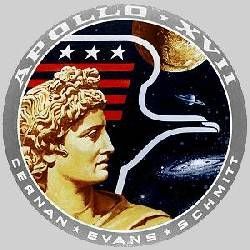 | Apollo 17 Credit: www.spacefacts.de |
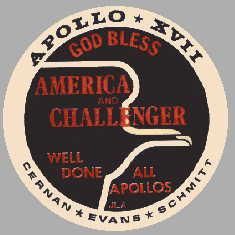 | Apollo 17 Apollo 17 Patch Credit: NASA |
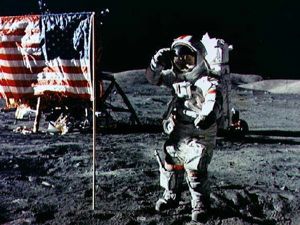 | Apollo 17 A geologist on the moon Credit: NASA |
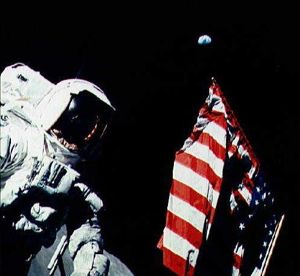 | Apollo 17 Astronaut, flag, moon Credit: NASA |
 | Apollo 17 Apollo 17 base camp Credit: NASA |
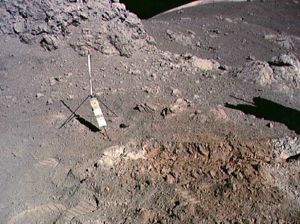 | Apollo 17 Orange soil Credit: NASA |
1969 July 29 - .
- Tentative planning schedule for the Apollo program - .
Nation: USA.
Program: Apollo.
Flight: Apollo 12,
Apollo 13,
Apollo 14,
Apollo 15,
Apollo 16,
Apollo 17,
Apollo 18,
Apollo 19,
Apollo 20.
Spacecraft: Apollo Lunar Landing,
Surveyor.
NASA issued a tentative planning schedule for the Apollo program:
Flight Launch Plans Tentative Landing Area Apollo 12 November 1969 Oceanus Procellarum lunar lowlands Apollo 13 March 1970 Fra Mauro highlands Apollo 14 July 1970 Crater Censorinus highlands Apollo 15 November 1970 Littrow volcanic area Apollo 16 April 1971 Crater Tycho (Surveyor VII impact area) Apollo 17 September 1971 Marius Hills volcanic domes Apollo 18 February 1972 Schroter's Valley, riverlike channel-ways Apollo 19 July 1972 Hyginus Rille region-Linear Rille, crater area Apollo 20 December 1972 Crater Copernicus, large crater impact area
1972 July 13 - .
- Photographic tasks of command module pilot during Apollo 17 - . Nation: USA. Program: Apollo. Flight: Apollo 17. Spacecraft: Apollo CSM. A meeting at NASA Hq. reviewed the proposed photographic and visual observation tasks of the command module pilot during the Apollo 17 mission scheduled for December. Feasibility of the tasks and potential flight planning impact were discussed..
1972 July 15 - .
- Lunar Science Institute's summer study on post-Apollo lunar science - .
Nation: USA.
Program: Apollo.
Flight: Apollo 17.
Spacecraft Bus: Apollo LM.
Spacecraft: Apollo ALSEP.
The Lunar Science Institute's summer study on post-Apollo lunar science arrived at a number of conclusions and recommendations. Some conclusions were: Lunar science would evolve through three rather distinct phases. For two years immediately following Apollo 17, high priority would be given to collection, organization, and preliminary analysis of the wealth of information acquired from the exploration of the moon. In the next two years (1975 and 1976), emphasis would shift to a careful first look at all the data. In the next years, investigations would be concentrated on key problems. Additional Details: here....
1972 September 26 - .
- MSC responsible for the medical briefing during Apollo 17 - .
Nation: USA.
Program: Apollo.
Flight: Apollo 17.
During the Apollo 17 mission, MSC would be responsible for the medical briefing at the mission reviews, would provide the medical staffing of the mission operations control room, would assume the medical line responsibilities in the operations team, and would provide mission surgeons to take part in the change-of-shift press briefings.
1972 December 7 - . 05:33 GMT - . Launch Site: Cape Canaveral. Launch Complex: Cape Canaveral LC39A. Launch Platform: LUT3. Launch Vehicle: Saturn V.
- Apollo 17 - .
Call Sign: America. Crew: Cernan,
Evans,
Schmitt.
Backup Crew: Duke,
Roosa,
Young.
Payload: Apollo CSM 114/LM 12/ ALSEP/ LRV-3/S-IVB-512. Mass: 30,342 kg (66,892 lb). Nation: USA.
Agency: NASA Houston.
Program: Apollo.
Class: Moon.
Type: Manned lunar spacecraft. Flight: Apollo 17.
Spacecraft: Apollo CSM.
Duration: 12.58 days. Decay Date: 1972-12-19 . USAF Sat Cat: 6300 . COSPAR: 1972-096A. Apogee: 167 km (103 mi). Perigee: 167 km (103 mi). Inclination: 28.53 deg. Period: 87.83 min.
Apollo 17 (AS-512), the final Apollo manned lunar landing mission, was launched from Pad A, Launch Complex 39, KSC, at 12:33 a.m. EST December 7. Crew members were astronauts Eugene A. Cernan, Ronald E. Evans, and Harrison H. Schmitt. The launch had been delayed 2 hours 40 minutes by a countdown sequencer failure, the only such delay in the Apollo program caused by a hardware failure.
All launch vehicle systems performed normally in achieving an earth parking orbit of 170 by 168 kilometers. After checkout, insertion into a lunar trajectory was begun at 3:46 a.m.; translunar coast time was shortened to compensate for the launch delay. CSM 114 transposition, docking with LM-12, and LM ejection from the launch vehicle stage were normal. The S-IVB stage was maneuvered for lunar impact, striking the surface about 13.5 kilometers from the preplanned point at 3:27 p.m. EST December 10. The impact was recorded by the passive seismometers left on the moon by Apollo 12, 14, 15, and 16.
The crew performed a heat flow and convection demonstration and an Apollo light-flash experiment during the translunar coast. The scientific instrument module door on the SM was jettisoned at 10:17 a.m. EST December 10. The lunar orbit insertion maneuver was begun at 2:47 p.m. and the Apollo 17 spacecraft entered a lunar orbit of 315 by 97 kilometers. After separation of the LM Challenger from the CSM America and a readjustment of orbits, the LM began its powered descent and landed on the lunar surface in the Taurus-Littrow region at 2:55 p.m. EST on December 11, with Cernan and Schmitt.
The first EVA began about 4 hours later (6:55 p.m.). Offloading of the lunar roving vehicle and equipment proceeded as scheduled. The Apollo Lunar Surface Experiment Package was deployed approximately 185 meters west northwest of the Challenger. Astronaut Cernan drove the lunar roving vehicle to the experiments deployment site, drilled the heat flow and deep core holes, and emplaced the neutron probe experiment. Two geological units were sampled, two explosive packages deployed, and seven traverse gravimeter measurements were taken. During the 7-hour 12-minute EVA, 14 kilograms of samples were collected.
The second extravehicular activity began at 6:28 p.m. EST December 12. Because of geological interest, station stop times were modified. Orange soil was discovered and became the subject of considerable geological discussion. Five surface samples and a double core sample were taken in the area of the orange soil. Three explosive packages were deployed, seven traverse gravimeter measurements were taken, and observations were photographed. Samples collected totaled 34 kilograms during the 7 hours and 37 minutes of the second EVA.
The third and final EVA began at 5:26 p.m. EST December 13. Specific sampling objectives were accomplished. Samples - including blue-gray breccias, fine-grained vesicular basalts, crushed anorthositic rocks, and soils - weighed 66 kilograms. Nine traverse gravimeter measurements were made. The surface electrical properties experiment was terminated. Before reentering the LM, the crew selected a breccia rock to dedicate to the nations represented by students visiting the Mission Control Center. A plaque on the landing gear of the lunar module, commemorating all of the Apollo lunar landings, was then unveiled. After 7 hours 15 minutes, the last Apollo EVA on the lunar surface ended. Total time of the three EVAs was approximately 22 hours; the lunar roving vehicle was driven 35 kilometers, and about 115 kilograms of lunar sample material was acquired.
While Cernan and Schmitt were exploring the lunar surface, Evans was conducting numerous scientific activities in the CSM in lunar orbit. In addition to the panoramic camera, the mapping camera, and the laser altimeter, three new scientific instrument module experiments were included in the Apollo 17 orbital science equipment. An ultraviolet spectrometer measured lunar atmospheric density and composition; an infrared radiometer mapped the thermal characteristics of the moon; and a lunar sounder acquired data on the subsurface structure.
Challenger lifted off the moon at 5:55 p.m. EST December 14. Rendezvous with the orbiting CSM and docking were normal. The two astronauts transferred to the CM with samples and equipment and the LM ascent stage was jettisoned at 1:31 a.m. December 15. Its impact on the lunar surface about 1.6 kilometers from the planned target was recorded by four Apollo 17 geophones and the Apollo 12, 14, 15, and 16 seismometers emplaced on the surface. The seismic experiment explosive packages that had been deployed on the moon were detonated as planned and recorded on the geophones.
During the coast back to earth, Evans left the CSM at 3:27 p.m. EST December 17 for a 1-hour 7-minute inflight EVA and retrieved lunar sounder film and panoramic and mapping camera cassettes from the scientific instrument module bay. The crew conducted the Apollo light- flash experiment and operated the infrared radiometer and ultraviolet spectrometer.
Reentry, landing, and recovery were normal. The command module parachuted into the mid-Pacific at 2:25 p.m. EST December 19, 6.4 kilometers from the prime recovery ship, U.S.S. Ticonderoga. The crew was picked up by helicopter and was on board the U.S.S. Ticonderoga 52 minutes after the CM landed. All primary mission objectives had been achieved.
- Apollo 17 LM - . Call Sign: Challenger. Payload: Apollo LM 12. Mass: 16,448 kg (36,261 lb). Nation: USA. Agency: NASA Houston. Program: Apollo. Class: Moon. Type: Manned lunar spacecraft. Flight: Apollo 17. Spacecraft: Apollo LM. Duration: 12.58 days. Decay Date: 1972-12-19 . USAF Sat Cat: 6300 . COSPAR: 1972-096x. Apogee: 167 km (103 mi). Perigee: 167 km (103 mi). Inclination: 28.53 deg. Period: 87.83 min.
1972 December 12 - . 23:54 GMT - .
- EVA Apollo 17-1 - . Crew: Cernan, Schmitt. EVA Duration: 0.30 days. Nation: USA. Related Persons: Cernan, Schmitt. Program: Apollo. Class: Moon. Type: Manned lunar lander. Flight: Apollo 17. Spacecraft: Apollo LM. Explored lunar surface near LM and deployed ALSEP unmanned scientific station equipment..
1972 December 13 - . 23:28 GMT - .
- EVA Apollo 17-2 - . Crew: Cernan, Schmitt. EVA Duration: 0.32 days. Nation: USA. Related Persons: Cernan, Schmitt. Program: Apollo. Class: Moon. Type: Manned lunar lander. Flight: Apollo 17. Spacecraft: Apollo LRV. Drove in lunar rover to South Massif..
1972 December 14 - . 22:25 GMT - .
- EVA Apollo 17-3 - . Crew: Cernan, Schmitt. EVA Duration: 0.30 days. Nation: USA. Related Persons: Cernan, Schmitt. Program: Apollo. Class: Moon. Type: Manned lunar lander. Flight: Apollo 17. Spacecraft: Apollo LRV. Drove in lunar rover to North Massif..
1972 December 15 - .
- EVA Apollo 17-4 - . Crew: Cernan, Schmitt. EVA Duration: 0.0014 days. Nation: USA. Related Persons: Cernan, Schmitt. Program: Apollo. Class: Moon. Type: Manned lunar lander. Flight: Apollo 17. Spacecraft: Apollo LM. Internal Vehicular Activity. Threw excess equipment out of LM before lift-off..
1972 December 15 - .
- EVA Apollo 17-5 - . Crew: Cernan, Schmitt. EVA Duration: 0.0007 days. Nation: USA. Related Persons: Cernan, Schmitt. Program: Apollo. Class: Moon. Type: Manned lunar lander. Flight: Apollo 17. Spacecraft: Apollo LM. Internal Vehicular Activity. Threw excess equipment out of LM before lift-off..
1972 December 17 - . 20:27 GMT - .
- EVA Apollo 17-6 - . Crew: Evans, Schmitt. EVA Duration: 0.0458 days. Nation: USA. Related Persons: Evans, Schmitt. Program: Apollo. Class: Moon. Type: Manned lunar spacecraft. Flight: Apollo 17. Spacecraft: Apollo CSM. Stand-Up External Vehicular Activity. Deep space retrieval of film cartridges from Service Module..
1972 December 19 - .
- Landing of Apollo 17 - .
Return Crew: Cernan,
Evans,
Schmitt.
Nation: USA.
Related Persons: Cernan,
Evans,
Schmitt.
Program: Apollo.
Flight: Apollo 17.
Reentry, landing, and recovery were normal. The Apollo 17 command module parachuted into the mid-Pacific at 19:25 GMT, 6.4 kilometers from the prime recovery ship, U.S.S. Ticonderoga. The crew was picked up by helicopter and was on board the U.S.S. Ticonderoga 52 minutes after the CM landed. Manned exploration of the moon had ended.
1974 January 4 - .
- 93 Apollo 17 lunar plaque presented to various countries - . Nation: USA. Program: Apollo. Flight: Apollo 17. Of the 134 Apollo 17 lunar plaques, 93 were presented by American embassies to the countries in which the embassies were located..
1998 April 5 - .
- From the Earth to the Moon is released. - .
Nation: USA.
Flight: Apollo 11,
Apollo 12,
Apollo 13,
Apollo 14,
Apollo 15,
Apollo 17,
Apollo 7,
Apollo 8,
Apollo 9.
Based on the success of the film Apollo 13, Tom Hanks was able to raise $ 68 million to film a television mini-series covering the entire Apollo program. The Apollo 13 episode marked the third fictionalised telling of the tale, this time concentrating on the media handling of the flight and the changing nature of television news. Additional Details: here....
Back to top of page
Home - Search - Browse - Alphabetic Index: 0- 1- 2- 3- 4- 5- 6- 7- 8- 9
A- B- C- D- E- F- G- H- I- J- K- L- M- N- O- P- Q- R- S- T- U- V- W- X- Y- Z
© 1997-2019 Mark Wade - Contact
© / Conditions for Use